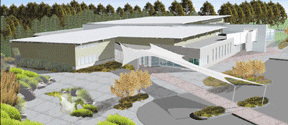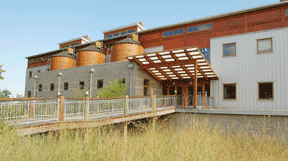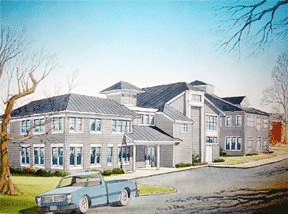The Greening of Good WorksCharity takes an eco-turnby Carrie Madren
With 400 needy people depending on Vicki Callahan, rain gardens and compost privies are pretty far down on her priority list. Yet she’s building a new, green $9 million home for her 300 differently abled workers and the 78 staffers who help them do their best. Crowded out of their old 30,000-square-foot industrial park site in Hanover, Opportunity Builders, the nonprofit Callahan directs, wanted a new home that lived up to its name: a home with wide open spaces, healthy interiors and lush green surroundings. But she didn’t anticipate how green Opportunity Builders’ new home in Millersville could be. “The building numbers came in lower than our worst-case scenario budget of $10.2 million,” says Callahan. “So we said, let’s put that $300,000 difference toward making it green.” Thus Opportunity Builders joins a select group of local non-profits with environmentally friendly homes. Shades of GreenOn a warm morning, men and women buzz about assembly-line tasks in a warehouse filled with machines and pallets of phonebooks and boxes. Workers feed boxes and parcels through rumbling shrink wrappers as colleagues label GoodWrap rolls, bagged phonebooks or packaged shoelace locks. Next January, these people and their jobs will move into Opportunity Builders’ new 41,000-square-foot green home on 14.5 acres in Millersville.
It’s a huge move for the group, which has been helping mentally and physically disabled adults since 1962. In Millersville, the center’s 30 vans will have a covered driveway to drop off clients. Workspaces will be lit with natural light, not fluorescent lights, and wide hallways will accommodate wheelchairs. Instead of scant views of the industrial park’s asphalt roads, large windows will show forest and green space. “The new building will be so much more open and bright,” says Leslie Prewitt, Opportunity Builders’ marketing manager. “Every hallway ends with a window that lets in light,” says Clarke Holmes, senior project manager from Purple Cherry Architects. Skylights, too, will reduce the need for artificial lighting during the day. Those high-efficiency windows will have recycled aluminum frames. When the sun beats down, a white reflective roof will reflect solar heat, keeping the interior cooler. Insulation made from recycled clothing fibers outworks conventional materials by 17 percent. At work, everybody will be more comfortable, Prewitt explains, with heating and cooling systems that keep heat inside the big warehouse during cooler months. At night, well-placed and directed outdoor lighting will cut light pollution. Builders are also using Forest Stewardship Council-certified wood; low-VOC carpeting and low-VOC paints; Marmoleum flooring, made from linseed oil; post-consumer industrial metal and ceiling tiles of 75 percent recycled materials. Some 20 percent of the materials used come from less than 500 miles away. Outside, water efficient landscaping — using native plants — will cut the need for irrigation, and a sediment pond will catch stormwater runoff. The construction process itself is green: Some 75 percent of scraps are sorted for recycling. For commuting staff and clients, “it’s a more central location in our transportation area, which will save gas,” Callahan says. Clients currently come to Hanover from as far as Southern Anne Arundel County and beyond. Her team mapped out their driving area, pinpointing Millersville and Gambrills as ideal locations. The people who work inside green buildings gain a range of benefits — from cleaner air with fewer chemicals to more natural light and Vitamin D. And they are able to take pride in their lightweight footprint on the Mother Earth. Opportunity Builders’ $300,000 investment brings comfort, sustainability and savings — both for the not-for-profit and for the planet. The Green AdvantageHigh yields in worker health and happiness also translate into real dollars for green companies and non-profits. Each year, buildings use more than 30 percent of our nation’s energy — and more than 60 percent of the country’s electricity, according to the U.S. Green Building Council, which oversees the most widely used stamp of approval for green buildings, Leadership in Energy and Environmental Design — known as LEED — certification. “A green building will perform so much better than a conventional building, and for a longer time at a higher level,” says Council spokeswoman Ashley Katz. That means noticeable savings on energy bills. Savings also come from workers’ health and well being. Some $20 to $160 billion in increased national worker productivity is earned each year because of green work environments, Katz says. “There’s better air quality, less mold and you don’t have any of those toxins,” she says. Healthier workers are more productive workers. Green buildings not only create a staying force for insiders; they also draw outside attention. Constructing an eco-friendly project is attractive to potential donors, for example. Opportunity Builders’ Callahan got her idea when a potential donor asked if the new center would be green. The excitement generated by a green building can also boost capital campaigns, according to the Atlanta Food Bank, which created a LEED toolkit for non-profits. The Food Bank found that nonprofits housed in green buildings have board members, staff and volunteers who are proud of the building and their group’s commitment to the environment. But LEED certification adds its own costs. LEED silver and gold — higher standards than entry-level certification — typically costs between two to three percent of the building’s price tag, according to David Pratt, president of the Baltimore chapter of the Green Building Council. That’s up to $50,000 for mechanical systems, certification fees and paying a third-party LEED expert to commission the building and make sure its systems and setup work as they should. Pratt argues that the extra cost for LEED is worthwhile. Without certification, he says, “It’s like taking a test and saying I think I should get 90 percent.” So far, the Opportunity Builders team is willing to guess rather than pay for the test.
Green PioneerChesapeake Country’s LEED pioneer is Chesapeake Bay Foundation, which completed its 30,600-square-foot, $6.36 million Phillip Merrill Center in 2001. The environmental giant earned Platinum LEED certification — the first in the world to rack up enough points for the highest certification level — by designing a headquarters that featured nearly every green building trick in the book. Geothermal wells plunge 300 feet deep to both heat and cool the center. South-facing windows let in natural light to illuminate the entire building. Composting toilets, solar panels, cork flooring, rooftop rainwater cisterns and ventilating windows add to the green roster. Plus, 51 percent of the materials were found within 300 miles of the site. The abundance of natural light and green living at Chesapeake Bay Foundation’s headquarters in Annapolis has become a “great recruitment tool and retention tool for staff,” says Mary Tod Winchester, noting that the Foundation is inundated with applications for every job opening. Phillip Merrill Center has also become a destination for engineering students, contractors and environmentalists. Best of all, Winchester says, their state-of-the-art green building keeps saving them money. It cost no more than an institution of similar scope would pay for marble lobby floors and other niceties, the Foundation noted in a planning document. Savings in energy and water use continue to add returns on the original investment. The $25,000 composting toilets save some $2,100 per year on water and sewage, compared to a comparable non-green office of 100 people with conventional toilets. In about a decade, that investment will cost out. The Foundation uses 40 percent less energy and saves some $22,000 per year in energy costs, compared to a comparable non-green building. A Lighter Shade of GreenIn North Beach, the nine-year-old Bayside Boys & Girls Club used to gather kids ages six to 18 in a triple-wide trailer for fun, fitness, health and life skills, education, arts and more. Two and a half years ago, the non-profit moved up to the North Beach Community Center while building a new $1.8 million youth development center, where up to 200 kids will visit each day. The center was built for economy. But when green choices fit the budget, Boys & Girls Clubs of Southern Maryland made them. The new clubhouse would not pass a LEED test. But it will be supported by nine-inch Styrofoam-insulated walls: two and a half inches of foam sandwiched between thick walls of concrete. Windows are also energy efficient. Both green aspects yield dual energy-saving goals: a cleaner environment and slimmer electric bills.
“The insulation will keep it cooler in the summer and warmer in the winter,” says Pamela Wilkerson, director of Boys & Girls Clubs of Southern Maryland. The durable walls, made with kids in mind, will also keep maintenance costs down, notes Lloyd Robertson, construction manager for the town of North Beach. The new greener building, to be dedicated Labor Day weekend, will achieve education as well as energy savings. “We try to foster a sense of environmental responsibility among kids,” says Chief Operating Officer Jon Tucker, whose young charges already bear responsibility for painting do not litter signs. “Having efficient windows and walls, that enhances the kids’ feeling they can take care of community and environment.” The Green RewardBuilding green in Maryland also earns a tax break from the Maryland Energy Administration — up to eight percent of the new building’s cost. To get the tax credit, buildings must meet LEED Silver requirements — but needn’t be certified by the U.S. Green Building Council — and must be located in Priority Funding Areas or brownfields. More impressive are daily savings. “Up-front costs of about two percent to support green design would, on average, result in life-cycle savings of 20 percent of total construction costs — more than 10 times the initial investment,” Capital E, with the U.S. Green Building Council, reported in 2003. Chesapeake Bay Foundation bears out that conclusion. Its super-green center claims savings of over $80,000 each year in operating costs. For non-profits that want the best of both worlds — to do good in their missions and for the environment — going green may also be its own reward.
|
||||||||
|
|
||||||||
|
© COPYRIGHT 2008 by New Bay Enterprises, Inc. All rights reserved.
|





